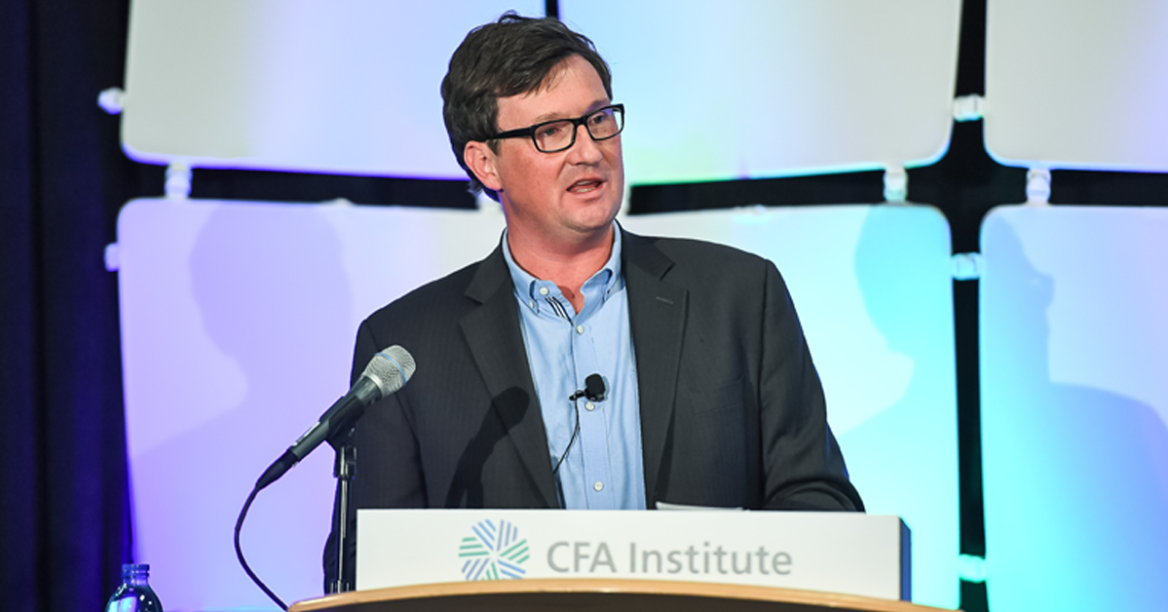Invest-Tech: The Next Phase of Fintech Innovation
by Charles Henneman, CFA, CFA Institute
These days, it seems everyone in the investment business wants to talk about fintech. What does it mean for my firm? What does it mean for my job? How can we use it? How can we survive it?
And what is “fintech” anyway? Are we talking crypto-currencies, the blockchain, and a whole new architecture for the global payment system?
Is it shorthand for the “robo-advisers,” which look poised to transform the advisory business and have introduced the existential fear of being replaced by robots into the human cohort of professional advisers?
It seems that fintech (used with or without a hashtag) means all that and much more and could completely revolutionize what we think of as the asset management industry.
“What is the production function of investment returns?” Ashby Monk asked his master class audience at the 69th CFA Institute Annual Conference in Montréal.
“All institutional investors produce the same thing, which is money,” he said. “You add human capital, plus info and data, plus process, and you earn a rate of return. This is the production function of investing.”
Monk is the executive and research director of the Stanford Global Projects Center, where his research is focused on improving the production function of investment for long-term investors. He explained the mission of the Global Projects Center:
“There is a lot of theoretically long-term capital in the world — $70 trillion by our estimates — in pensions, sovereign funds, endowments, foundations, family offices, insurance companies, and so on. But these long-term investors are investing over shorter and shorter time horizons. This behavior is odd, as it rejects some of the key advantages of a long-term investor — time and scale — and plays into the hands of financial intermediaries and also leaves critical projects for the future of humans unfunded.”
When applied to the investment production function, technology will augment people in different ways and will streamline aspects of the investment process.
“‘Invest-tech,’ a subset of fintech, is technology that raises expected risk-adjusted net returns,” Monk said.
“It’s a conventional misperception that this is all about boosting alpha through speed,” he continued. “The reality is that invest-tech has the potential to permeate all organizational processes and systems. The entire production function can be augmented.”
Next-generation invest-tech has two main building blocks: artificial intelligence (AI) and big data.
“All invest-tech rests on two pillars: data latency, which is the speed in acquiring or processing error-free inputs, and inferential depth, which is the profoundness and durable accuracy of insights,” Monk said.
He explained that financial technology throughout history has been primarily focused on latency — increasing the speed of acquiring information and executing transactions. But there are debates now about how far continued improvements in processing speed may go, but we are nowhere near any recognizable limit in inferential depth.
“The rate at which speed is increasing is less important than the rate at which inference is deepening,” Monk said, citing recent advances in AI that include the first ever AI victory in a grandmaster-level game of Go with a bizarre, illogical-looking move. “The world of AI has been buzzing with this development.”
Monk traced the history of invest-tech from clay tablets in ancient Babylon, to carrier pigeons, to the invention of the digital circuit. The knowledge that any form of logic can be reproduced on a digital circuit was the beginning of the union between inference and latency.
“It was a long boring marriage until computer power grew enough to take advantage of it,” he said.
Which brings us to current times, when “amazing technologies are coming,” according to Monk. “Are we ready? Heck no.”
To illustrate examples of what the imminent invest-tech wave will bring, Monk highlighted two companies he has worked with: Predata and Orbital Insight.
Predata is developing a tool to listen to social media and collaborative data (i.e., “big data”) and extract metadata, which it mines for signals, using machine learning to trace patterns in ways we barely understand. “It has literally predicted a terrorist attack,” Monk said
Orbital Insight, meanwhile, is developing a “macroscope for understanding Earth,” combining geospatial data captured by satellites with machine vision (MV) and parallel processing to track not only current economic activity but also the trajectories of changes. Captured data include cars in parking lots and on roads, crop coverage, and smoke plumes, as well as other evidence of activity at factories, the shadow-length at construction sites, and other observable data that can be mined and analyzed for more accurate economic forecasting.
Monk said that the clients for these types of services thus far have largely been governments and global energy companies. But while the tech may have been developed and first used for other purposes, “the amount of tech that’s being built that will obviously end up in finance is astounding.”
In research to be published in 2016, Monk notes that institutional asset owners see “transformative promise in next-gen invest-tech” but also anticipate challenges in implementing new technology and face what he calls the “technological investor’s dilemma.”
Is there an advantage in moving first? Which functions and processes should we “technologize”? Is it better to be an early adopter or free ride until standards emerge? These are not easy questions.
“I can name two firms that each spent more than $100 million on systems that sit idle today,” he said.
Monk noted there are a host of issues that will need to be thoroughly examined as AI takes on a prominent role in the investment function, including issues of trust and accountability with automated systems and the implications for fiduciary duty.
But technology is already rapidly changing how we engage with the world, and what that means for finance and investing is profound. The combination of improved data latency and inferential depth enable investment processes that are more bottom up and objectively sound and that could ultimately channel capital in ways better purposed toward mission.
“What invest-tech allows is a critical reexamination of what mission is versus what it could be,” Monk said.
For truly long-term investors, this may include longer-term stewardship that is more socially minded and the cultivation of partnerships rather than the “exploitation of fleeting arbitrages.”
“Ultimately, greater depth of inference could extend investment time horizons,” Monk explained. “That’s the Holy Grail,”
This article originally appeared on the 69th CFA Institute Annual Conference blog.
If you liked this post, don’t forget to subscribe to the Enterprising Investor.
All posts are the opinion of the author. As such, they should not be construed as investment advice, nor do the opinions expressed necessarily reflect the views of CFA Institute or the author’s employer.
Photo courtesy of W. Scott Mitchell
Copyright © CFA Institute















